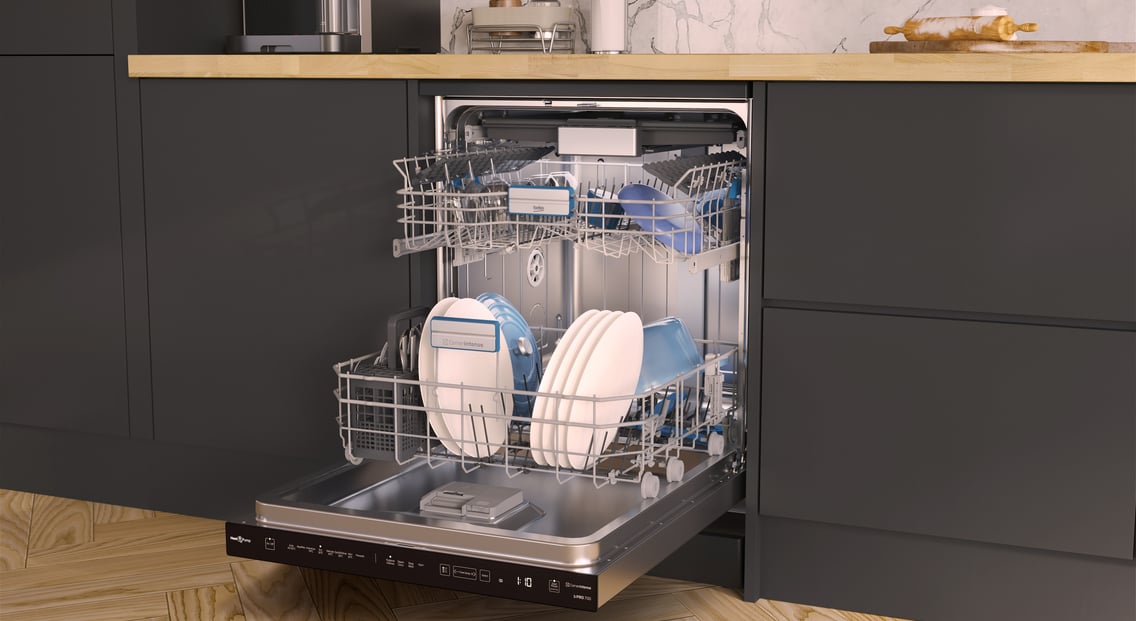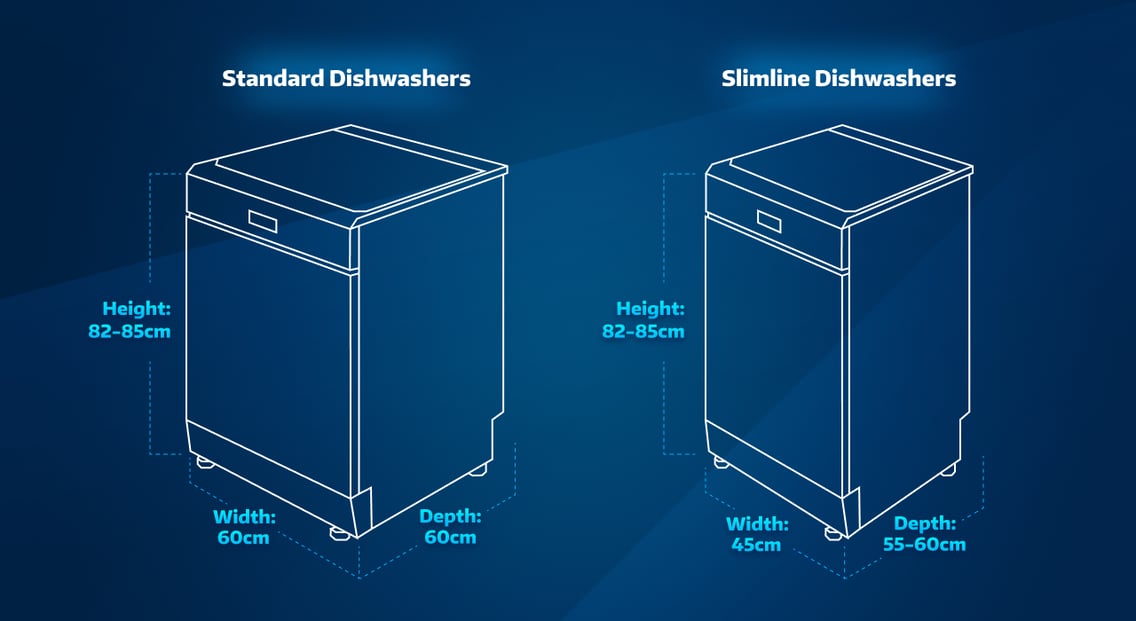Dishwasher Measurement Guides: Ensuring the Perfect Fit for Your Kitchen

Shopping for a new dishwasher can be exciting, but it can also be a headache if you haven’t measured your space correctly. The last thing you want is to bring home a shiny new appliance only to discover it doesn’t fit where it’s supposed to go! Accurate dishwasher measurements are key to ensuring a smooth installation and avoiding costly surprises.
In this guide, we'll walk you through the steps to measure your kitchen space, explain common pitfalls to avoid, and help you select the right dishwasher size based on your needs.
How to Measure for Your New Dishwasher
Before purchasing a dishwasher, taking precise measurements of the available space in your kitchen is crucial for ensuring your built-in appliance fits perfectly. Here’s how to measure correctly:
- Height measurement: Using a tape measure, start by measuring from the top of your counter down to the floor. This height (H) is essential to ensure the dishwasher fits well within the cabinetry. The standard height for most dishwashers is around 85cm, but it’s vital to confirm your specific measurements. Be sure to check for any obstacles, such as pipes or electrical outlets, that might interfere with the installation.
- Width measurement: Next, measure the width (W) of the space where the dishwasher will be installed. This measurement is taken from side to side and should be noted in centimetres (cm). Standard full-sized dishwashers measure around 60cm wide, while slimline models are approximately 45cm. Remember to account for any mouldings or trim around the cabinetry that might affect the available width.
- Depth measurement: Finally, measure the depth (D) of the space by gauging from the wall to the front edge of the cabinetry. Standard dishwashers typically require about 60cm in depth, but again, make sure to consider any pipes or electrical connections behind the unit that may reduce this space.
- Measure at multiple points: It’s important to measure several points in each dimension since the dimensions can vary in different areas. This helps to ensure that you’re accounting for any irregularities in your kitchen space.
- Consider door swing clearance: Additionally, ensure there’s enough room for the dishwasher door to open fully without hitting any cabinets or walls. Proper clearance in front of the dishwasher is necessary for convenient loading and unloading.
Understanding Standard Dishwasher Measurements

Dishwashers come in several sizes, and picking the right one depends on your available space and the needs of your household. Here’s a breakdown of the most common types:
- Standard size dishwashers: Typically, these are 60cm wide, 60cm deep, and 82-85cm high, ideal for larger families or homes with more space. They offer ample capacity for daily use, and most kitchen spaces are designed with this size in mind.
- Slimline dishwashers: With a width of around 45cm, these are the perfect solution for smaller kitchens with limited space. Slimline dishwashers also maintain the same 82-85cm height and 55-60cm depth as standard dishwashers, but they offer less internal space, making them a better fit for couples or small households.
Common Mistakes to Avoid When Measuring for a Dishwasher
Measuring for a dishwasher seems straightforward, but there are several common errors that can lead to issues during installation. Here’s how to avoid them:

Only Measuring The Width
Many people focus solely on width, neglecting the height and depth. All three dimensions are equally important for ensuring a good fit.

Forgetting About Hoses and Connections
Dishwashers need space at the back for plumbing and electrical connections. Always leave extra room behind the appliance to account for these fittings.

Overlooking Uneven Floors
If your kitchen floor is uneven, it could cause the dishwasher to sit at an angle. Make sure to measure from the highest point of the floor to avoid misalignment.
Tips for Choosing the Right Dishwasher Size

Once you’ve taken your measurements, the next step is selecting the best dishwasher for your kitchen. Here’s what to keep in mind:
- Match capacity to household needs: Larger households will benefit from a full-size dishwasher that can handle frequent, large loads. However, if you live alone or in a small household, a slimline model might be the more energy-efficient choice.
- Consider space for door swing: Ensure that there’s enough space in front of the dishwasher for the door to open completely. If the door can’t open all the way, loading and unloading will be much harder.
- Additional features: Some dishwashers come with adjustable racks and flexible interior designs, allowing you to fit large pots or pans more easily. If you’re tight on space but need versatility, these features can make all the difference.
How to Ensure a Seamless Installation
Getting your dishwasher to fit perfectly is just one part of the process. The installation needs to go smoothly as well. Here are some tips for a hassle-free installation:
- Double-check measurements: It can’t be said enough, double-check all your measurements before making your final purchase. Errors at this stage can be costly and time-consuming to correct.
- Consult a professional installer: If you’re unsure about your measurements or the installation process, it’s always a good idea to seek professional help. Installing a dishwasher involves dealing with plumbing and electrical connections, so having an expert can prevent any major mishaps. Many retailers offer installation services at the point of purchase.
- Leave space for ventilation: Dishwashers need room to ventilate, so be sure to leave a small gap around the sides and back to prevent overheating and ensure optimal performance.
Frequently Asked Questions Measuring Dishwashers
How do I measure for a dishwasher if my cabinets are not standard sizes?
Measure the available space as accurately as possible and consider a slimline or compact dishwasher if your cabinets are narrower or shorter than standard sizes. withal Beko dishwashers come with adjustable feet for easier fitting in non-standard spaces.
What should I do if my space is slightly smaller than the standard dishwasher dimensions?
In some cases, you can adjust cabinetry to make room for the dishwasher. Alternatively, you may need to opt for a smaller slimline or compact model that fits in the space available.
How important is it to leave extra space around the dishwasher? requires repair?
Leaving a small gap around the dishwasher allows for ventilation and prevents the appliance from getting wedged too tightly. It’s also important for ensuring easy access to the back for maintenance and connections.
Can I install a dishwasher myself?
If you have some DIY experience and are comfortable working with plumbing and electrical outlets, you can install a dishwasher yourself. However, hiring a professional ensures that the installation is done correctly and safely.
What features should I look for in a new dishwasher?
Beyond size, look for features such as energy efficiency ratings, noise levels, adjustable racks, and additional technologies like CornerIntense™ which has uniquely rotating spray arms for intensive cleaning or Fast45 which can wash and dry a full load of dishes in just 45 minutes. These features can enhance your dishwasher’s performance and make it more user-friendly.
By taking accurate measurements and understanding the different dishwasher sizes available, you can confidently select an appliance that fits your kitchen perfectly. Whether you opt for a standard or slimline model, careful preparation will ensure a hassle-free installation and years of reliable dishwashing.



